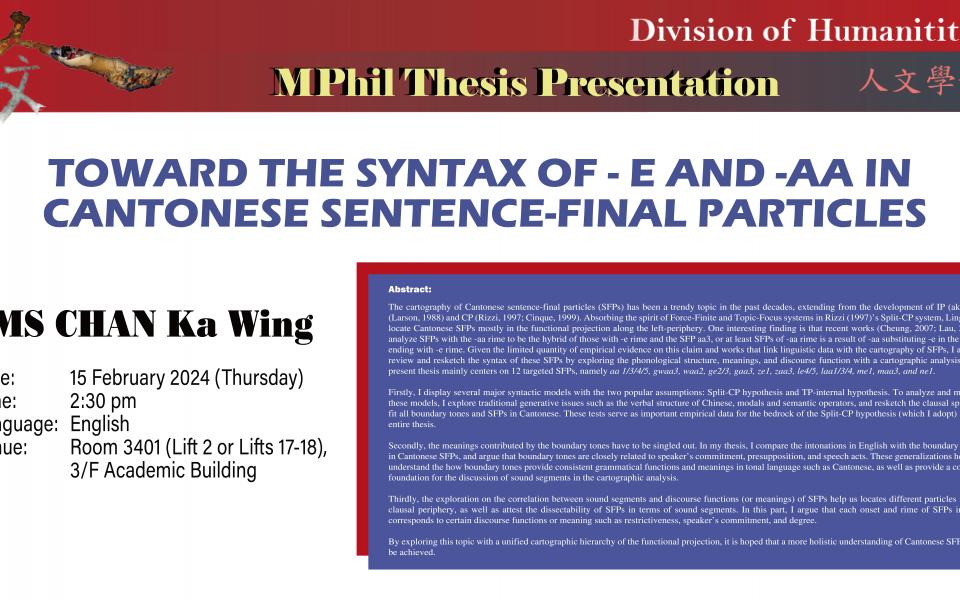ABSTRACT:
The cartography of Cantonese sentence-final particles (SFPs) has been a trendy topic in the past decades, extending from the development of IP (aka.TP) (Larson, 1988) and CP (Rizzi, 1997; Cinque, 1999). Absorbing the spirit of Force-Finite and Topic-Focus systems in Rizzi (1997)’s Split-CP system, Linguists locate Cantonese SFPs mostly in the functional projection along the left-periphery. One interesting finding is that recent works (Cheung, 2007; Lau, 2019) analyze SFPs with the -aa rime to be the hybrid of those with -e rime and the SFP aa3, or at least SFPs of -aa rime is a result of -aa substituting -e in the SFPs ending with -e rime. Given the limited quantity of empirical evidence on this claim and works that link linguistic data with the cartography of SFPs, I aim to review and resketch the syntax of these SFPs by exploring the phonological structure, meanings, and discourse function with a cartographic analysis. The present thesis mainly centers on 12 targeted SFPs, namely aa1/3/4/5, gwaa3, waa2, ge2/3, gaa3, ze1, zaa3, le4/5, laa1/3/4, me1, maa3, and ne1.
Firstly, I display several major syntactic models with the two popular assumptions: Split-CP hypothesis and TP-internal hypothesis. To analyze and modify these models, I explore traditional generative issues such as the verbal structure of Chinese, modals and semantic operators, and resketch the clausal spine to fit all boundary tones and SFPs in Cantonese. These tests serve as important empirical data for the bedrock of the Split-CP hypothesis (which I adopt) in the entire thesis.
Secondly, the meanings contributed by the boundary tones have to be singled out. In my thesis, I compare the intonations in English with the boundary tones in Cantonese SFPs, and argue that boundary tones are closely related to speaker’s commitment, presupposition, and speech acts. These generalizations help us understand the how boundary tones provide consistent grammatical functions and meanings in tonal languages such as Cantonese, as well as provide a concise foundation for the discussion of sound segments in the cartographic analysis.
Thirdly, the exploration on the correlation between sound segments and discourse functions (or meanings) of SFPs help us locates different particles in the clausal periphery, as well as attest the dissectability of SFPs in terms of sound segments. In this part, I argue that each onset and rime of SFPs indeed corresponds to certain discourse functions or meaning such as restrictiveness, speaker’s commitment, and degree.
By exploring this topic with a unified cartographic hierarchy of the functional projection, it is hoped that a more holistic understanding of Cantonese SFPs can be achieved.
